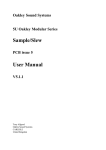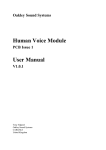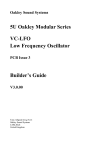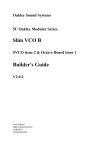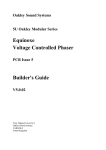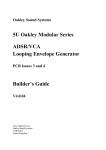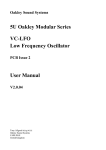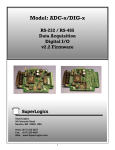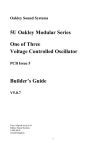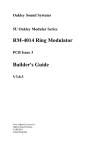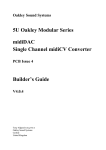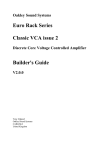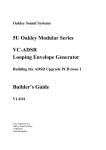Download VRG issue 1 Builder`s Guide
Transcript
Oakley Sound Systems 5U Oakley Modular Series Versatile Ramp Generator VRG PCB Issue 1 Builder's Guide V1.0.2 Tony Allgood B.Eng PGCE Oakley Sound Systems CARLISLE United Kingdom Introduction This is the Project Builder's Guide for the issue 1 Versatile Ramp Generator (VRG) 5U module from Oakley Sound. This document contains a basic introduction to the board, a full parts list for the components needed to populate the board or boards, and a list of the various interconnections. For the User Manual, which contains an overview of the operation of the unit and the calibration procedure, please visit the main project webpage at: http://www.oakleysound.com/vrg.htm For general information regarding where to get parts and suggested part numbers please see our useful Parts Guide at the project webpage or http://www.oakleysound.com/parts.pdf. For general information on how to build our modules, including circuit board population, mounting front panel components and making up board interconnects please see our generic Construction Guide at the project webpage or http://www.oakleysound.com/construct.pdf. 2 The Issue 1 VRG PCB This is the prototype issue 1 Oakley VRG module behind a natural finish 1U wide Schaeffer panel. Note the use of the optional Sock6 socket board to facilitate the wiring up of the six sockets. On the VRG printed circuit board I have provided space for the four main control pots. If you use the specified 16mm Alpha pots and matching brackets, the PCB can be held very firmly to the panel without any additional mounting procedures. The pot spacing on this board is different to many of our other 5U modules, instead of 1.625” it is 1.375”. Used in conjunction with smaller 20mm diameter knobs this still allows for an attractive module design and finger friendly tweaking. The design requires plus and minus 15V supplies. The power supply should be adequately regulated. The current consumption is +44mA and -37mA. Power is routed onto the main PCB by either our standard four way 0.156” MTA156 type connector or the special five way Synthesizers.com MTA100 header. The four pins are +15V, ground, earth/panel ground, -15V. The earth/panel connection allows you to connect the metal front panel to the power supply’s ground without it sharing the modules’ ground line. More about this later. The main PCB has four mounting holes for M3 bolts, one near each corner. These are not required for panel mounting if you are using the three 16mm pot brackets. The board size is 109mm (deep) x 124mm (high). The main board has been laid out to accept connection to our Sock6 socket board. This small board speeds up the wiring of the six sockets and reduces the chances of building mistakes. 3 VRG issue 1 Parts List For general information regarding where to get parts and suggested part numbers please see our useful Parts Guide at the project web page or http://www.oakleysound.com/parts.pdf. The components are grouped into values, the order of the component names is of no particular consequence. A quick note on European part descriptions. R is shorthand for ohm. K is shorthand for kiloohm. R is shorthand for ohm. So 22R is 22 ohm, 1K5 is 1,500 ohms or 1.5 kilohms. For capacitors: 1uF = one microfarad = 1000nF = one thousand nanofarad. To prevent loss of the small ‘.’ as the decimal point, a convention of inserting the unit in its place is used. eg. 4R7 is a 4.7 ohm, 4K7 is a 4700 ohm resistor, 6n8 is a 6.8 nF capacitor. Resistors 1% 0.25W or 0.4W metal film resistors are recommended. R15 can be 5% 0.25W. 22R 75R 220R 1K +3000ppm/K PTC 1K5 2K2 3K3 3K6 4K7 10K 15K 20K 22K 27K 47K 75K 82K 100K 120K 560K 1M 3M3 R26 R31 R62 R11, R22 R60 R53, R68 R1 R54 R19, R20 R6, R2, R35, R5, R50, R51, R48, R36 R61, R52 R30, R37 R32, R33, R24, R28, R27, R29 R12, R23 R39, R55, R43, R41, R63, R58, R45, R66, R57, R56, R67, R44, R65, R16, R18, R64 R40, R42 R47 R7, R21, R10, R9, R38, R8 R25, R13, R46, R4, R14, R3 R59 R34, R17, R49 R15 4 Capacitors 100nF axial ceramic 22pF C0G 2.5mm ceramic 100pF C0G 2.5mm ceramic 1nF, 63V polyester 100nF, 63V polyester 2u2, 63V electrolytic 22uF, 35V electrolytic C1, C7, C8, C10, C11, C12, C14, C15, C16, C17, C18, C20, C21 C4, C5 C13 C3, C6 C9, C19 C22, C23 C2 Discrete Semiconductors The polarisation of the 1N4148 diodes D16 and D17 are incorrectly marked on the PCB legend. They should be fitted so that the black band on the diode is towards the top of the board. Thus all four diodes, D16 through to D19, should all be facing the same way. 1N4148 signal diode 2V7 zener diode 6V2 zener diode BAT-42 Schottky diode BC550 NPN small signal transistor 5mm bi-colour LED (red/green) D1, D2, D13, D14, D15, D16, D17, D19, D6, D5 D10, D11 D9, D12, D18 D3, D4, D7, D8 Q1, Q2 LED Integrated Circuits 4001BE CMOS NOR gate DG403DJ dual analogue switch THAT340 NPN/PNP array LT1013CP AD712 dual FET op-amp TL072CN dual FET op-amp TL074CN quad FET op-amp LM4040DIZ-10.0 10V reference U11 U12 U7 U3, U6 U2 * U4, U8, U9, U10 U5 U1** * U2 should be a good quality FET if you want the lowest error voltages on your output signal. However, you get quite acceptable results using just a TL072CN. ** The LM4040CIZ-10.0 is also suitable. IC sockets are to be recommended. You need seven 8-pin, two 14-pin and one 16-pin DIL sockets. Trimmers (preset) resistors 5K multiturn cermet GAIN 5 Potentiometers (Pots) All pots Alpha 16mm PCB mounted types 47K or 50K linear UP, DOWN, UP_CV, DOWN_CV Three 16mm pot brackets. Switches One single pole ON-OFF-ON toggle switch is required for the mode selection. One single pole ON-OFF toggle switch is required for the LIN/EXP selection. Both switches are mounted on the panel and wired to the board with fly wires – see later for details. Miscellaneous Leaded axial ferrite beads L1, L2 MTA156 4 way header MTA100 6-way header PSU PWR – Oakley/MOTM power supply – Synthesizers.com power supply Molex/MTA 0.1” header 8-way Molex/MTA 0.1” housing 8-way UPR UPR – for connecting to sockets – for connecting to sockets Molex/MTA 0.1” header 4-way Molex/MTA 0.1” housing 4-way LWR LWR – for connecting to sockets – for connecting to sockets Molex/MTA 0.1” housing 2-way Optional connection method for the LED. LED clip and lens Other Parts Required Switchcraft 112APC 1/4” sockets Six off mounted either on the Sock6 board or on panel Four 20mm knobs. Around 2m of insulated multistrand hook up wire for the switch and socket connections. 6 Components required if using optional Sock6 board Molex/MTA 0.1” header 8-way Molex/MTA 0.1” housing 8-way UPR UPR Molex/MTA 0.1” header 4-way Molex/MTA 0.1” housing 4-way LWR LWR 112APC Switchcraft 1/4” socket SK1, SK2, SK3, SK4, SK5, SK6 L1 on the Sock6 PCB is not to be fitted. If using Molex KK you'll also need at least 24 crimp terminals. Suitable lengths of wire to make up the two interconnects and four cable ties. You should fill any unused solder pads with solder. In the VRG this means the unused power supply header location and all the little via holes. 7 Connections Power connections – MOTM and Oakley The PSU power socket is 0.156” Molex/MTA 4-way header. Friction lock types are recommended. This system is compatible with MOTM systems. Power Pin number +15V Module GND Earth/PAN -15V 1 2 3 4 Pin 1 on the I/O header has been provided to allow the ground tags of the jack sockets to be connected to the powers supply ground without using the module’s 0V supply. Earth loops cannot occur through patch leads this way, although screening is maintained. Of course, this can only work if all your modules follow this principle. It's worth filling the empty holes of the PWR pads with solder. Power connections – Synthesizers.com The PWR power socket is to be fitted if you are using the module with a Synthesizers.com system. In this case you should not fit the PSU header. The PWR header is a six way 0.1” MTA, but with the pin that is in location 2 removed. In this way location 3 is actually pin 2 on my schematic, location 4 is actually pin 5 and so on. Power Location number Schematic Pin number +15V Missing Pin +5V Module GND -15V Not connected 1 2 3 4 5 6 1 2 3 4 5 +5V is not used on this module, so location 3 (pin 2) is not actually connected to anything on the PCB. If fitting the PWR header, you will also need to link out pins 2 and 3 of PSU. This connects the panel ground with the module ground. Simply solder a solid wire hoop made from a resistor lead clipping to join the middle two pads of PSU together. 8 Building the VRG module using the Sock6 board This is the simplest way of connecting all the sockets to the main board. The Sock6 board should be populated in the way described in our construction guide found on the project webpage. There are only two headers, UPR (for upper) which is eight way, and LWR (for lower) which is four way. Both headers are fitted to the bottom side of the board. The wire link L1 should not be fitted to the Sock6 board. You need to make up two interconnects. The eight way one should be made so that it is 95mm long. The four way should be made to be 110mm. The VRG prototype module showing the detail of the board to board interconnect. Here I have used the Molex KK 0.1” system to connect the Sock6 to the main PCB. 9 Hand wiring the sockets If you have bought Switchcraft 112A sockets you will see that they have three connections. One is the earth or ground tag. One is the signal tag which will be connected to the tip of the jack plug when it is inserted. The third tag is the normalised tag, or NC (normally closed) tag. The NC tag is internally connected to the signal tag when a jack is not connected. This connection is automatically broken when you insert a jack. Once fitted to the front panel the ground tags of each socket can be all connected together with solid wire. I use 0.91mm diameter tinned copper wire for this job. It is nice and stiff, so retains its shape. A single piece of insulated wire can then be used to connect those connected earth tags to pin 1 of LWR. Pin 1 is the square solder pad. All the other connections are connected to the signal or NC lugs of the sockets. The tables below show the connections you need to make: UPR Pin Pad name Socket Lug Type Pin 1 Pin 2 Pin 3 Pin 4 Pin 5 Pin 6 Pin 7 Pin 8 Module ground GATE_IN UPCV_IN DOWNCV_IN Module ground UPCV_IN SLEW_NC SLEW_IN GATE IN GATE IN DOWN CV DOWN CV UP CV UP CV SLEW IN SLEW IN NC Signal NC Signal NC Signal NC Signal Pin Pad name Socket Lug Type Pin 1 Pin 2 Pin 3 Pin 4 Panel ground NEG_OUT Not used SLEW_OUT Connects to all sockets NEG OUT Ground lugs Signal OUTPUT Signal LWR 10 Wiring the Switches The VRG features two different types of switch. The three position ON-OFF-ON switch should go to the top of the module, while the ordinary two position ON-OFF switch should go to the middle hole in the panel. The ON-OFF-ON switch has all three tangs connected to the board and the ON-OFF one has just the two lower ones connected. You should wire each switch as you would other Oakley modules. I typically use thin solid core wire rather than insulated multi-strand wire. This keeps the connection firmly in place and very neat. I normally bend the wire at one end into a hook and place the straight end into the PCB pad's hole. I then loop the hooked end around the switch tang and squash the hook into place before soldering it. The solder pad on the board can then be soldered from the underside and the excess wire on snipped off. The prototype unit showing the solid core wire connections between the toggle switches and the PCB. 11 Wiring the LED The VRG features a bi-colour LED and this is wired in similar fashion to other Oakley 5U modules. I recommend that you use a twisted wire pair to connect the LED to the board. The twisted pair's end is stripped back and soldered into the board. A clear LED lens and matching clip holds the LED into the panel. The Molex KK housing and crimps make a reliable solderless connection to the LED's leads. 12 Testing the VRG Apply power to the unit making sure you are applying the power correctly. Check that no device is running hot. Any sign of smoke or strange smells turn off the power immediately and recheck the polarity of the power supply, the two transistors Q1 and Q2, the direction of the ICs in their sockets and the polarity of the electrolytic capacitors. Select the LFO mode using the three way switch. You should notice the LED start to glow or flash. Check that turning the UP and DOWN controls affect the speed of the flash. Start with both controls fully counter clockwise and then turn up the down control. At first the LED should be a blur of red and green. Only at lower speeds will you notice the separate colours. With the down pot at it's maximum setting the LED should take a long time to change colour and intensity. Now check that with the down pot at its lowest setting (ie. fast) changing the up control has a similar effect on the speed of the pulsating. You can verify the LFO's behaviour by plugging it into another module in your system. Try modulating the frequency of an audio VCO or a self-oscillating filter. Note that flicking between the LIN and EXP modes changes the sound somewhat as well as the frequency of the modulation. The LIN mode should produce a faster modulation from the VRG. If you require a brighter light from the LED then you can reduce the value of R60. I don't recommend that you go below 1K though as this will draw excessive current from your power supply. Now select ONE SHOT. The VRG should now stop oscillating. Connect a short patch lead between the NEG OUT and the GATE input. The VRG should start oscillating again but this time the LED should only be one colour as the VRG's output is now only going from +0.6V to around +5V. I normally wire my bi-colour LEDs to go red with a positive output voltage so here I would expect to see a red pulsating light. Again flicking between LIN and EXP should reveal that the LIN mode produces faster pulses. Remove the patch lead from NEG OUT. Select TRAD AD on the VRG and use a gate signal from your modular to trigger the VRG's attack-decay envelope generator (EG). Use the VRG's output to modulate a VCA or filter. Check that the up and down controls behave in the same way as attack and decay would on a normal ADSR. Listen to the difference between the LIN and EXP modes. Notice how the LIN mode gives rise to sharper sounds while the EXP is more natural in the way it opens and closes the VCA or filter. Still using the VRG as a traditional attack-decay EG verify the operation of the CV input sockets and controls. Remember that the controls are reversible attenuators and the minimum setting is in the middle of the rotation. If all this happens, the chances are that you have a working module and it is now time to calibrate. The User Manual gives full details on how to calibrate your module. 13 Final Comments If you have any problems with the module, an excellent source of support is the Oakley Sound Forum at Muffwiggler.com. Paul Darlow and I are on this group, as well as many other users and builders of Oakley modules. If you can't get your project to work, then Oakley Sound Systems are able to offer a 'get you working' service. If you wish to take up this service please e-mail me, Tony Allgood, at my contact e-mail address found on the website. I can service either fully populated PCBs or whole modules. You will be charged for all postage costs, any parts used and my time at 25GBP per hour. Most faults can be found and fixed within one hour, and I normally return modules within a week. The minimum charge is 25GBP plus return postage costs. If you have a comment about this builder's guide, or have a found a mistake in it, then please do let me know. But please do not contact me or Paul Darlow directly with questions about sourcing components or general fault finding. Honestly, we would love to help but we do not have the time to help everyone individually by e-mail. Last but not least, can I say a big thank you to all of you who helped and inspired me. Thanks especially to all those nice people on the Synth-diy and Analogue Heaven mailing lists and those at Muffwiggler.com. Tony Allgood at Oakley Sound Cumbria, UK © November 2011 – updated January 2012 No part of this document may be copied by whatever means without my permission. 14















